Emily Lakdawalla • Jul 07, 2016
Oppositions, conjunctions, seasons, and ring plane crossings of the giant planets
When are the solstices and equinoxes on the giant planets, and when are they best positioned for view from Earth? I ask these questions a lot as I write about Earth photos of giant planets, and I finally decided to gather the answers to those questions in a single post. I queried the JPL Horizons database for all the dates that I was looking for, figuring I'd save myself time looking up these dates for future posts. "Save myself time," ha! Famous last words. I spent all day playing with data tables and figuring out what they meant. In this post, I'll list orbital information for Neptune, Uranus, Saturn, and Jupiter. (If you're interested in Mars, here's an explainer on Mars' seasonal calendar; I'll cover Mars, Venus, and Mercury orbital events in a future post.)
One warning: the dates in this post, particularly ones many decades in the past or future, are approximate. Also, there are a variety of mathematical expressions and reference frames for the positions and orientations of the outer planets, and depending on which set you use, you could get answers that are different by a few days. The appearances of the outer planets don’t change very much within timescales of a few days anyway.
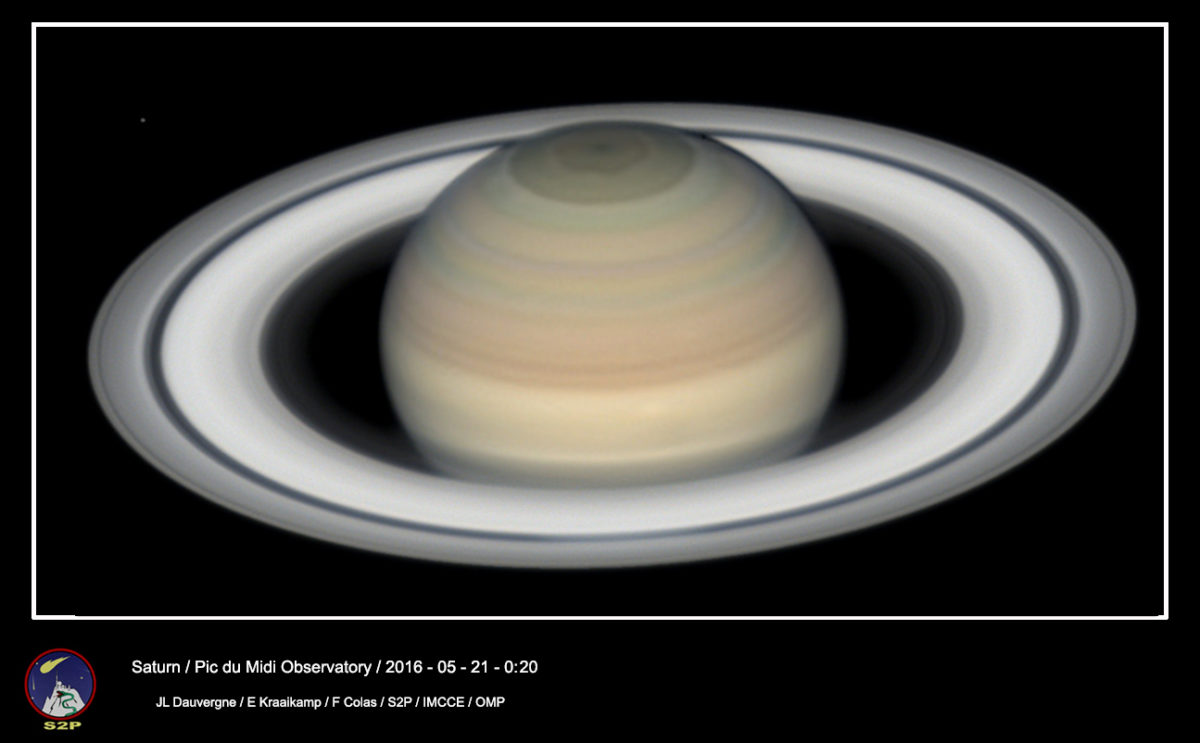
Some quick definitions: Opposition is when the Sun-Earth-planet angle is at a maximum, for planets beyond Earth; it's when the planet is opposite to the position of the Sun. The angle would be 180 degrees if all the planets' orbits were coplanar, but the orbits are all a little bit inclined with respect to each other. Opposition also happens near the date that Earth is closest to the planet within one synodic period (the time from one opposition to another). I usually think of opposition as being the best time to get photos of a planet because of the minimum distance, but although that may be true for Mars, relative proximity doesn't help you much with the giant planets. They are so far away that the relative closeness doesn't dramatically affect how big they appear. What opposition does for giant planet observers is to improve the opportunity that observers have to see them. When a planet is at opposition, it's up all night long, so you have a lot of dark sky time to observe it every night.
Conjunction is when the Sun-Earth-planet angle is at a minimum, that is, when the Sun and planet are very close to each other in the sky. Again, if the orbits were coplanar, the angle would be zero, but sometimes an outer planet passes above or below the Sun as seen from the Earth, not directly behind it, so the angle doesn’t go to zero. For one or two months around conjunction, it's impossible to observe an outer planet from Earth through conventional telescopes, and communications with spacecraft located at the planet are made difficult or impossible by the Sun's radio noise. Planetary missions plan for this by curtailing their transmission requirements during these periods.
A handy way to remember these first two terms is to remember that Earth is at the center. Opposition is when things are on opposite sides of the Earth; Conjunction is when they’re together. This may seem pre-Copernican, but that’s the point of origin of us stargazers, and therefore the origin of the terms.
Another event of interest for these planets is ring-plane crossings (usually abbreviated as "RPXs" or “RPCs”). For all these planets, the inner moons and rings orbit in (or very close to) a plane that's coincident with the planet's equator. Planetary equinoxes are defined by the Sun crossing the ring plane, just as the Sun crosses through our equator for Earth’s. Since Earth is located close to the Sun, we are usually on the same side of a planet's ring plane as the Sun is, so we see the rings illuminated most of the time. But because the orbits of the other planets and Earth have slightly different inclinations, Earth doesn't cross the ring plane on the same day that the Sun does, at equinox. For the period of time that Earth and the Sun are on different sides of the rings, Earth observers are treated to a very thin view of the shadowed side of the rings. In some years, the combination of Earth and planet's motions in their orbits means that Earth crosses the ring plane a total of three times around each equinox.
The synodic period of two orbiting bodies – in our case, the Earth and an outer planet – can be defined as the time between oppositions (or conjunctions). In other words, the time required for the two bodies to “line up” and return to the same relative orientation. Since the outer planets move much more slowly around the Sun than the Earth, the synodic period between the Earth and each outer planet is slightly more than one Earth year (and is of course different for each outer planet, as they move at different speeds). The Earth makes an orbit around the Sun in one year, but must then “catch up” to the planet as it has traveled in its own orbit.
I'll start with the slowest-moving planet and move inward.
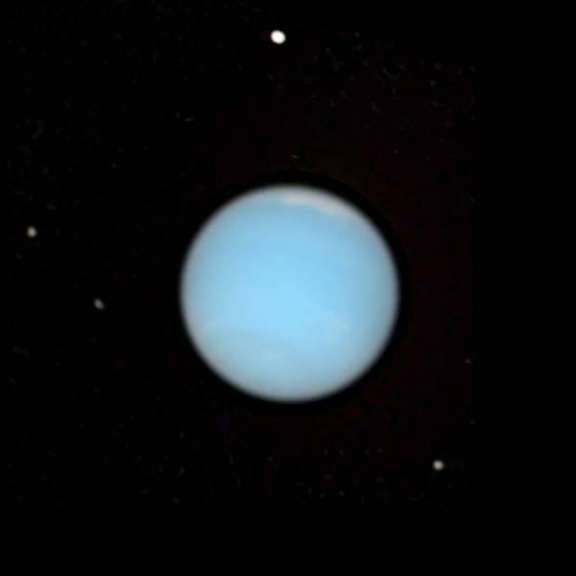
Neptune
Neptune's years are 164 Earth years long, so its seasons last more than 40 years. Its last equinox was in on July 11, 1963. Southern summer solstice, with the Sun at its lowest latitude of 29.16 degrees south, was March 6, 2005 (photo above). The southern autumnal equinox doesn't arrive until April 4, 2046. Equinoxes are a good time to explore planets and their moons, because they're a period of rapid change in atmospheres and ring systems and you get to observe both poles of planets and moons. I hope we can get a mission to Neptune around the time of its equinox, or not long after.
Because Neptune is so very slow-moving, the dates of its oppositions and conjunctions only change by about two days, year over year. In the 1980s, oppositions were in June. From 1989 through 2001, they were in July. Since 2015, oppositions have been in September. In 2033 opposition will shift to October.
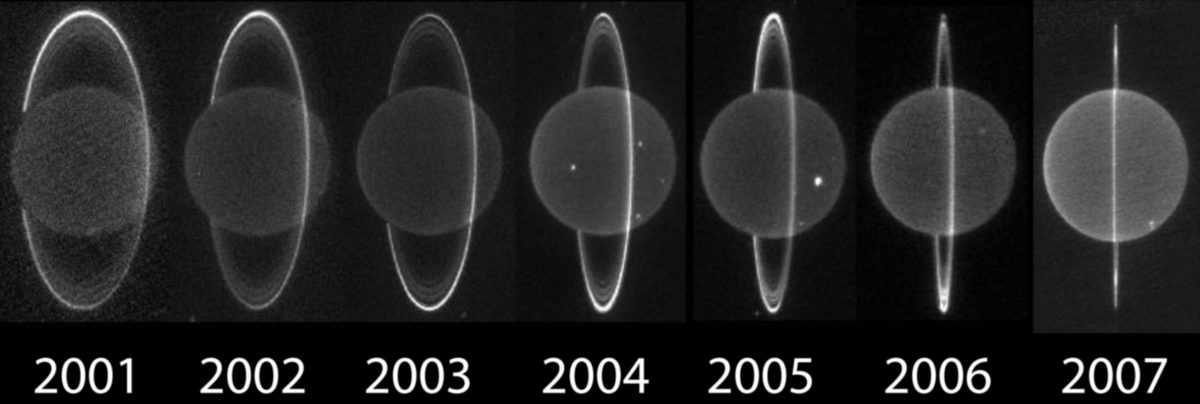
Uranus
Uranus travels around the Sun about twice as fast as Neptune, with years lasting 84 Earth years, and seasons lasting more than 20 Earth years. Its northern vernal equinox was on December 7, 2007. There were ring plane crossings on May 2, 2007; August 16, 2007; and February 20, 2008. Its northern summer solstice will be on April 11, 2030. The next equinox will be in February 2050. Hey, wouldn't it be awesome if we built identical spacecraft to explore Uranus and Neptune in the 2040s while both planets are close to their stormy equinoxes and showing us both poles of all their moons?
One can dream.
Uranus' oppositions move four days later every year. Right now, they happen in October. It'll be November for most of the 2020s, and December through 2034. If you think about it, it makes sense that Uranus' and Neptune's oppositions and conjunctions are fairly close in time to each other -- Uranus and Neptune had to be lined up (hence, both near opposition at the same time) for the Voyager 2 flybys in the 1980s, and Uranus has been overtaking Neptune on its marginally faster inside track around the Sun ever since.

Saturn
Saturn's years are 29.5 Earth years long, its seasons averaging 7.4 Earth years. The Pioneer and Voyager flybys, in 1979 to 1981, happened around the northern vernal equinox; the Cassini mission arrived just after the northern winter solstice in 2004. Here is a table of seasons for Saturn, beginning with the northern vernal equinox that happened before the launches of the Pioneers.
Year | Ls=0 (spring equinox) | Ls=90 (summer solstice) | Ls=180 (autumn equinox) | Ls=270 (winter solstice) |
|---|---|---|---|---|
1 | 22 Sep 1950 | 3 Jul 1958 | 16 Jun 1966 | 21 May 1973 |
2 | 3 Mar 1980 | 9 Dec 1987 | 19 Nov 1995 | 25 Oct 2002 |
3 | 11 Aug 2009 | 23 May 2017 Cassini ends 2017 | 6 May 2025 | 10 Apr 2032 |
4 | 23 Jan 2039 | 31 Oct 2046 | 10 Oct 2054 | 13 Sep 2061 |
5 | 29 Jun 2068 | 12 Apr 2076 | 27 Mar 2084 | 1 Mar 2091 |
Here's a graphical explainer of Saturn's seasons:
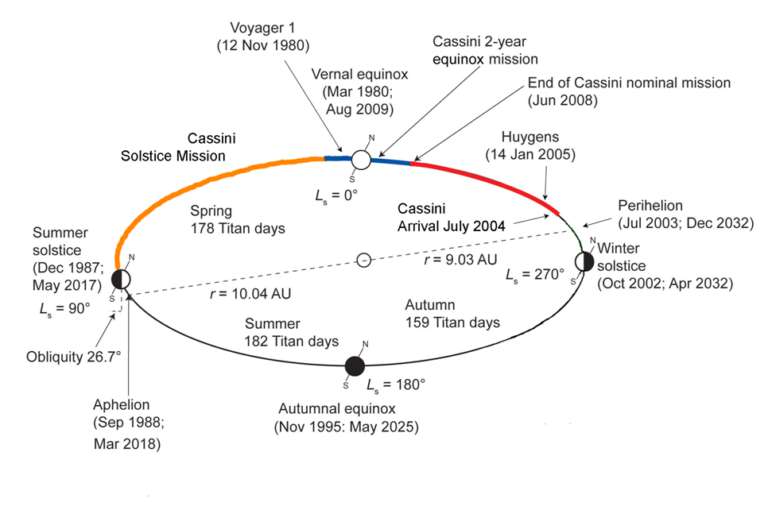
Note that Saturn's perihelion occurs just after northern winter solstice, so, just like Mars, Saturn and its moons have shorter, warmer northern winters and longer, cooler northern summers, while the seasons in the south are more extreme.
Because Saturn's rings are so showy, ring-plane-crossing seasons are especially rewarding. The rings appear to "vanish" for the weeks that Earth is on the shadowed side of the rings. Here are all the equinoxes and related ring plane crossings from 1950 to 2090:
Earth RPX just before equinox | Saturn Equinox (Sun RPX) | Earth RPX just after equinox | Closest opposition to equinox |
15 Sep 1950 | 22 Sep 1950 | -- | 20 Mar 1951 |
2 Apr 1966 | 16 Jun 1966 | 28 Oct 1966 | 20 Sep 1966 |
27 Oct 1979 | 3 Mar 1980 | 12 Mar 1980 | 14 Mar 1980 |
22 May 1995 | 19 Nov 1995 | 12 Feb 1996 | 15 Sep 1995 |
-- | 11 Aug 2009 | 4 Sep 2009 | 9 Mar 2009 |
23 Mar 2025 | 6 May 2025 | -- | 21 Sep 2025 |
15 Oct 2038 | 23 Jan 2039 | 1 Apr 2039 | 17 Mar 2039 |
6 May 2054 | 10 Oct 2054 | 1 Feb 2055 | 16 Sep 2054 |
| 29 Jun 2068 | 25 Aug 2068 | 10 Mar 2068 |
14 Mar 2084 | 27 Mar 2084 | -- | 23 Sep 2084 |
Saturn oppositions happen two weeks later every year. Saturn is at opposition today, June 3, 2016. Saturn was at opposition in January in 1975 and again in January in 2004 and will be again in January in 2034.
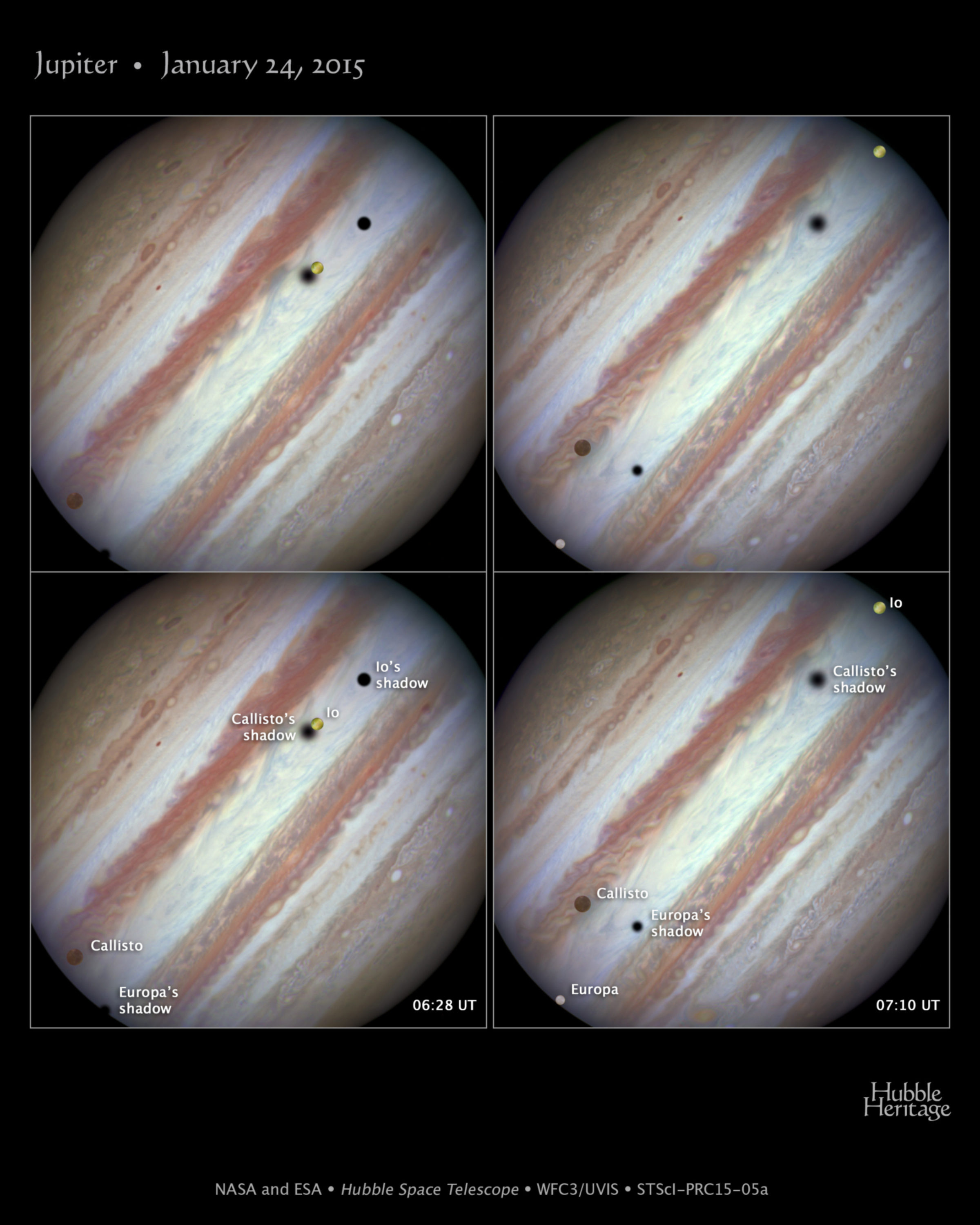
Jupiter
With its low orbital inclination (about 3 degrees), seasons on Jupiter are somewhat irrelevant to Jupiter's weather and to the visible illumination of the poles of the planet and satellites. But seasonal variations at Jupiter do have one notable effect: whenever Earth is close to Jupiter's ring plane (near Jupiter's equinoxes), observers can witness mutual events, where the moons cross each other and the face of Jupiter. Jupiter's 12-year orbit means that these mutual event seasons happen once every six years. And also like at Saturn, there are some equinoxes where there are three, rather than one, ring plane crossings. Those are especially good years for mutual event observations, because Earth spends so much time very close to the ring plane. In addition to being fun to observe, mutual event observations help astronomers measure satellite orbital motions to very high precision. Another event associated with equinoxes is triple shadow transits, like the one above; they can only happen when Jupiter is close enough to equinox that wide-orbiting Callisto's shadow falls on the planet.
Jupiter oppositions are about 13 months apart. Jupiter observers talk about Jupiter "apparitions," a period of time around each opposition when Jupiter isn't lost in the Sun's glare. Here are all the oppositions since 1990 (when Hubble launched) and until 2040, with notes on which apparitions also have a ring plane crossing, and, therefore, opportunities to observe mutual events and triple shadow transits.
- 29 Jan 1991 (RPX happens near the next conjunction)
- 29 Feb 1992
- 31 Mar 1993
- 30 Apr 1994
- 1 Jun 1995
- 4 Jul 1996
- 10 Aug 1997 (RPX 14 May 1997 and a pair of RPXs in Oct 1997)
- 16 Sep 1998
- 24 Oct 1999
- 28 Nov 2000
- 1 Jan 2002
- 2 Feb 2003 (RPX 24 Jun 2003)
- 4 Mar 2004
- 4 Apr 2005
- 5 May 2006
- 6 Jun 2007
- 9 Jul 2008
- 14 Aug 2009 (RPX 15 Apr 2009)
- 21 Sep 2010
- 29 Oct 2011
- 3 Dec 2012
- 6 Jan 2014
- 7 Feb 2015 (RPX 8 Nov 2014, 13 Apr 2015, and 3 May 2015)
- 8 Mar 2016
- 8 Apr 2017
- 9 May 2018
- 11 Jun 2019
- 14 Jul 2020
- 20 Aug 2021 (RPX 24 Mar 2021)
- 27 Sep 2022
- 3 Nov 2023
- 8 Dec 2024
- 10 Jan 2026
- 11 Feb 2027 (RPX 13 Oct 2026)
- 13 Mar 2028
- 12 Apr 2029
- 13 May 2030
- 15 Jun 2031
- 19 Jul 2032
- 25 Aug 2033 (RPX 4 Mar 2033)
- 2 Oct 2034
- 8 Nov 2035
- 13 Dec 2036
- 15 Jan 2038
- 15 Feb 2039 (RPX 22 Sep 2038)
I hope this information is useful to people as it will be for me!
Acknowledgement: I'm very grateful to David Seal for his review and corrections on this post.
Let’s Go Beyond The Horizon
Every success in space exploration is the result of the community of space enthusiasts, like you, who believe it is important. You can help usher in the next great era of space exploration with your gift today.
Donate Today

 Explore Worlds
Explore Worlds Find Life
Find Life Defend Earth
Defend Earth

